The calendar showed March 16, 1978, when shortly after 9 a.m. a group of Red Brigades ambushed former Italian Prime Minister Aldo Moro in the center of Rome, executing his entourage and kidnapping him. After 54 days of fruitless negotiations with the Italian government and after the kidnappers realized that their demands would not be met, they murdered Moro on May 9.
It was by far the most important blow in the history of the Italian terrorist organization, a milestone in its activity, which essentially constituted the beginning of its end, since it led to its political and social marginalization and ultimately to its complete discredit. But before we move on to recounting the events of the kidnapping, let's first see some information about the two "protagonists", the Red Brigades on the one hand and Aldo Moro on the other.
THE RED BRIGADES (BRIGATE ROSSE)

At the end of the 60s, immediately after May 68, Italy experienced a political transformation at its base. Many members of revolutionary organizations took jobs in large workplaces such as Siemens, Pirelli and IBM to become one with the proletariat. These enlisted workers organized autonomously, rejecting the influence of unions and the Italian Communist Party (PCI) and favoring armed violence.
In 1969, the Political Metropolitan Collective, an organization that grew out of the workers' struggles at IBM, put the issue of armed struggle on the agenda of one of its meetings. A year later, in November 1970, the Red Brigades published "Announcement No. 1", referring to the Pirelli foremen in Milan. Brigate Rosse was "born", with founding members Alberto Franceschini, Renato Curcio and his wife, Margherita Cagol.
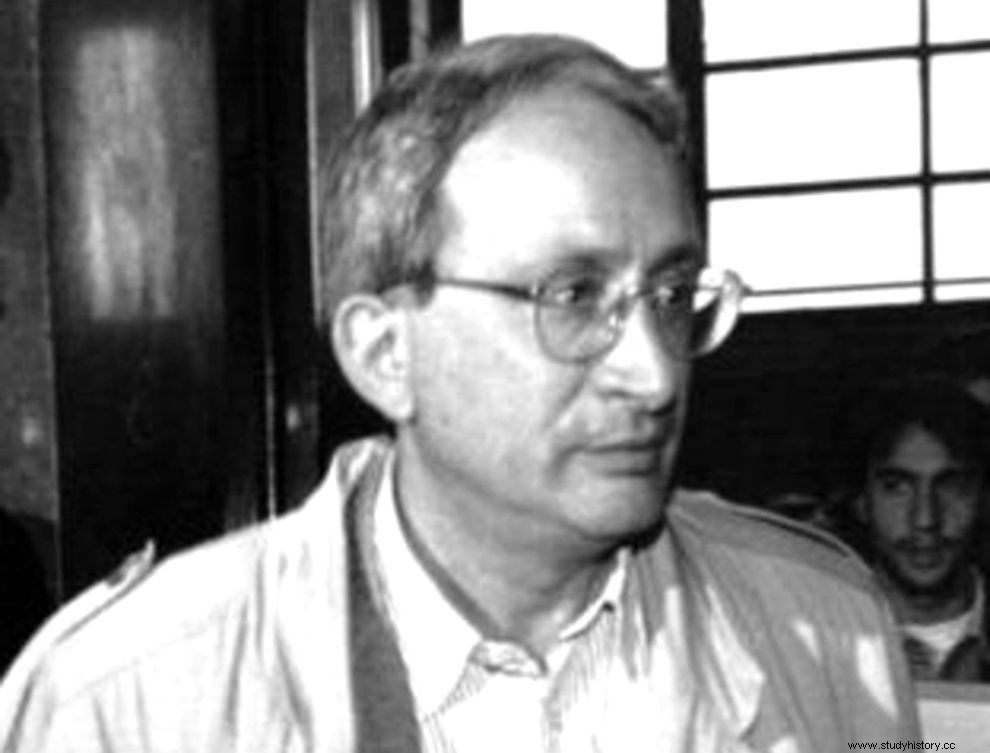
The "Trento group" of Curcio and Cagol had its roots in the Department of Sociology of the Catholic University of Trento (where they had both studied), while the "Rezzo-Emilia group" of Franceschini was mainly composed of former members of the FGCI (Federazione Giovanile Comunista Italiana), the youth of the Italian Communist Party, which had been deleted due to their extremist views. BR's first strikes were mainly sabotage of large factories in Italy.
In June 1974, the Red Brigades carried out their first murders, killing two members of the MSI (Movimento Sociale Italiano), an Italian neo-fascist party, during an attack on its offices in Padua. In September of the same year, Curcio and Franceschini were arrested by the Italian police, following information provided by Silvano Girotto, a police officer (and former monk) who had infiltrated the organization some time before.
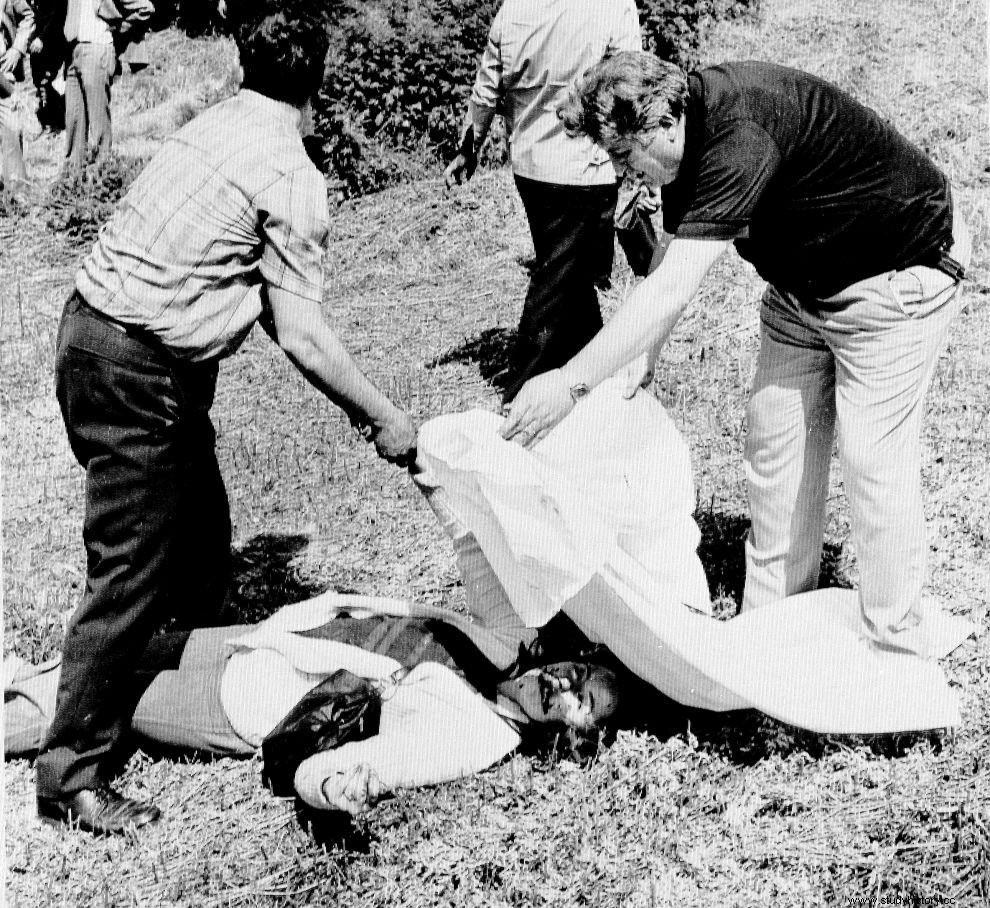
Renato Curcio was freed by a BR member (the plan was laid by Kagol), but was recaptured a few days later. The two leaders of the organization went through a trial and were sentenced to 18 years in prison. As early as 1974, the BR had spread throughout northern Italy and had changed their modus operandi, adopting the kidnapping of politicians and industrialists, as well as bank robberies. In 1975, the Italian police discovered the farmhouse in which the Red Brigades were holding the kidnapped industrialist Valarino Gancia.
In the fight that followed, two carabinieri were killed, as well as Margherita Cagol, while shortly after Giorgio Semeria was arrested, leaving the hardline Mario Moretti as the only leader of the organization. From the very first years of their existence, the Red Brigades were a completely special case on the map of European terrorist organizations. A real collaboration with the working world first developed and then it developed into an impressive network of members and sympathizers.
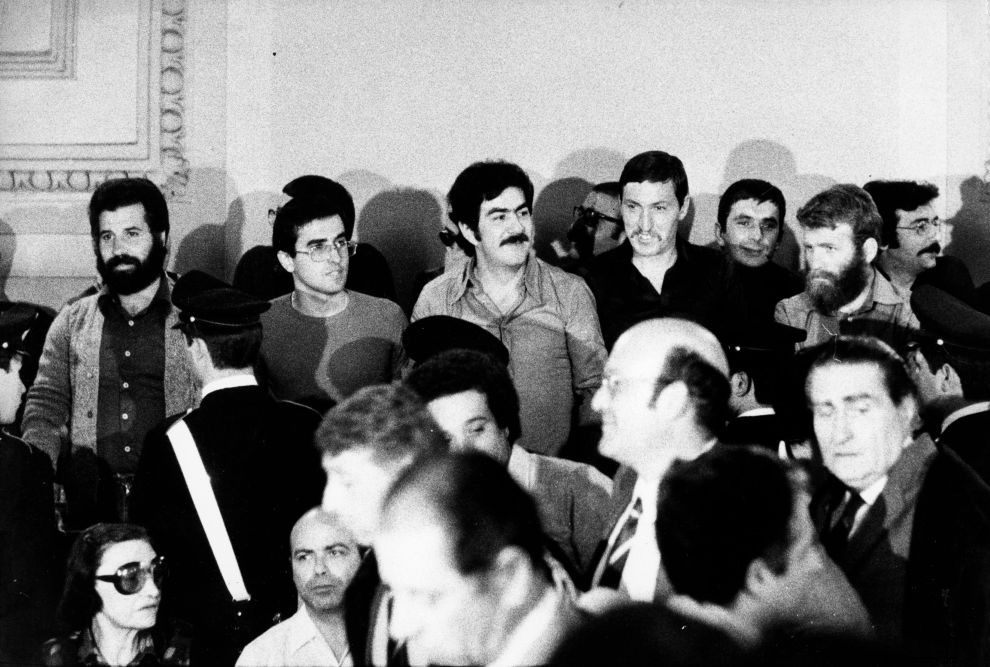
Starting with actions that could be characterized as forms of armed "unionism", they took full advantage of the special weight of the Italian Communist Party, which was also the main reservoir from which they drew members, but also the organizational ability of Curcio first and Moretti later , who very carefully constructed the ideological framework of the BRs. The "historic compromise" between the Christian Democrats and the IKK (1976), brought even more disillusioned - mainly young - communists into the ranks of the BR.
In every demonstration of the Left, thousands of young people participated who formed with the index of the hand the symbol "P 38", i.e. the barrel of the revolver, which became the emblem of the movement. The murders of political and financial figures, as well as policemen and journalists, followed one another, but the trap was set from within, when the organization itself was complacently left to the uncontrolled growth of its members. In the end, all that violence achieved was to continuously mask a structural crisis, which erupted after the Moro affair.
WHO WAS ALDO MORRO (1916-1978)

We now move on to the other "protagonist" of this story. Aldo Romeo Luigi Moro was born in 1916 in Malie, a small town near Lecce, at the southernmost tip of Puglia, in southeastern Italy. His father was a school inspector, while his mother was a teacher. In 1934 the family moved to Bari, where young Aldo studied Law at the local university. After graduating, he took a professorship at the same university, teaching philosophy of law and criminal law.
In 1935, while a freshman in law, Moro enrolled in FUCI (Federazione Universitaria Cattolica Italiana), the Italian Federation of Catholic Students, of which he became president in 1939. He held the position until 1942, when he went to fight at the front and succeeded Giulio Andreotti, then a law student in Rome. Moro had already shown his interest in politics and in March 1943 he was a founding member of the Christian Democratic Party (Democrazia Cristiana), belonging to its left wing.

In 1945 he married Eleonora Chiavarelli, with whom he had four children. In 1946 he became vice-president of the DC, while he was elected a member of the Constituent Assembly that worked on the drafting of the new Italian constitution. In 1948 he was elected for the first time to the House of Representatives, of which he was a member until his death in 1978. From 1948 to 1950 he served as Undersecretary of Foreign Affairs in the coalition government of Alcide de Gasperi. In 1955 he was re-elected to the Parliament and was president of the parliamentary group of the Christian Democrats.
In 1958 he became Minister of Education in the government of Amidore Fanfani and introduced the subject of Civic Education in schools. In 1959, Moro was elected general secretary of the Christian Democratic Party. In the national elections of 1963, after several processes, during which Moro had refused the position of prime minister, Giovanni Leone (DC) finally formed a coalition government (June 1963) with the support of the Socialists (PSI), the Democratic Socialists (PSDI) and the Republicans (PRI).
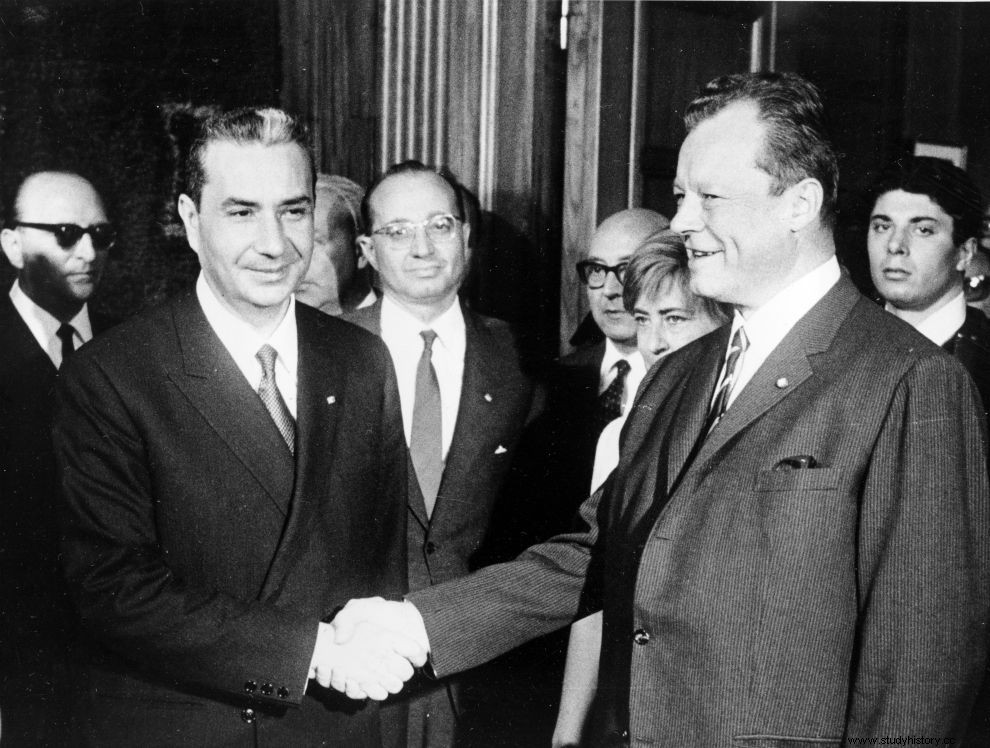
A few months later, when the Socialists (PSI) decided to become fully involved in the government structure, Leone resigned and Moro became the new Prime Minister of Italy. During his term (December 5, 1963 - June 25, 1968), Moreau implemented a program of major social reforms. He decided to give an annual stipend to low-income students. In 1965, a bill was passed that provided for the expansion of the Social Security program.
With the "Legge Ponte" law of 1967, Moreau introduced emergency provisions as part of a more general reform in the building sector, such as minimum standards for housing and the environment. In 1968 it made voluntary public preschool education for children ages 3-5 a law of the state. In addition, the legal minimum wage was increased, all current pensions were reassessed, while the possibility was given to workers with 35 years of contributions to be able to retire even if they had not reached the necessary age limit.

Something very important was the creation of a Social Fund (Fondo Sociale) by the National Institute of Social Security (INPS), guaranteeing to all its beneficiaries a basic uniform pension, known as the "social pension", which it financed in most of the state. At the same time, he decided on free health care for the unemployed and created an expanded family unemployment benefit for unemployed family heads.
Despite difficulties in consensus, the first centre-left coalition government in recent Italian history managed to stay in power for almost five years, until the 1968 national elections, where all Christian Democratic partners suffered major defeats. Moreau lost his allies and resigned. A year later, the also Christian Democrat prime minister, Mariano Rumor, gave Moro the foreign ministry. In 1971, he was nominated by the left wing of the DC as a candidate for the Presidency of the Republic, but the right wing of the party presented itself as diametrically opposed.
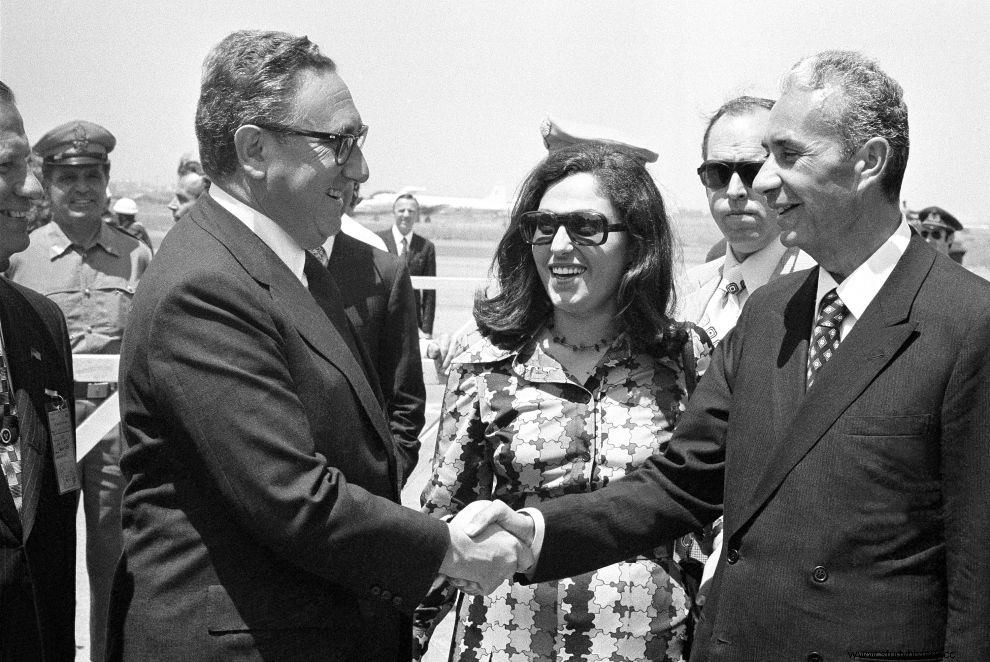
In October 1974, Rumor resigned, after the failure to reach an agreement to deal with the ever-increasing inflation, and the President of the Republic, Giovanni Leone, gave Moro the mandate to form a government. The Christian Democrats joined together with the Republicans, with the support (but not the participation) of the PSI and PSDI. So, on November 23, 1974, Aldo Moro was sworn in as the new prime minister, beginning his second term.
Social reforms continued, with special attention to pensioners, such as the automatic annual adjustment of minimum pensions. Despite the tensions in the governing coalition, Moro's very good relations with the leader of the Communist Party (PCI), Enrico Berlinguer, gave positive prospects for future collaborations. But in 1976, Francesco Di Martino, leader of the Socialists (PSI), withdrew his support for the government, resulting in Moro's resignation.
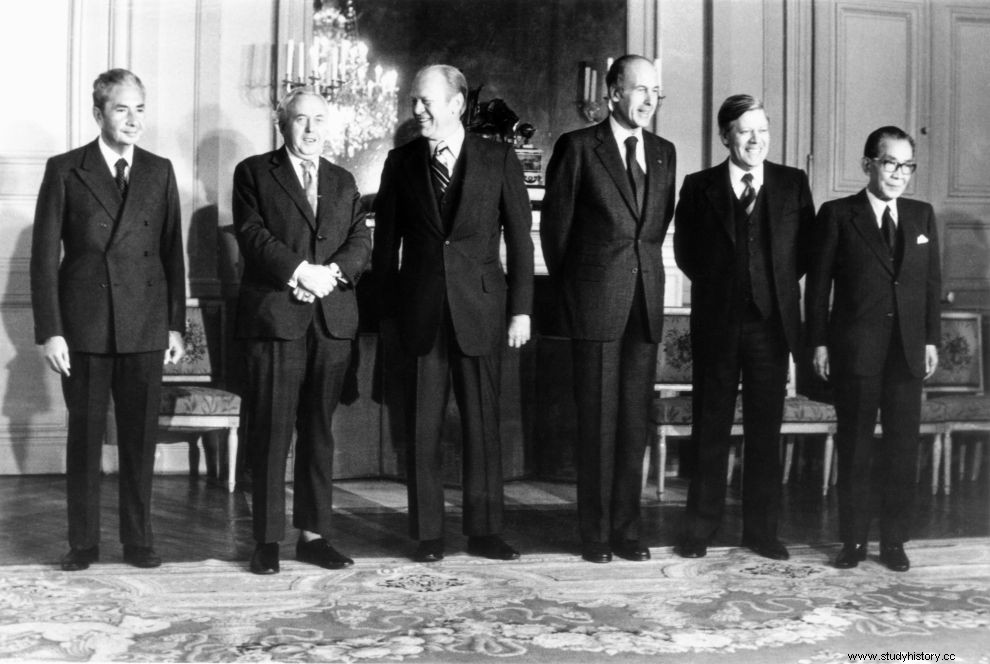
In June 1976, in the national elections, the Christian Democrats came first, maintaining their percentage (38.71%), but it was the Communists who made the big surprise, reaching an impressive 34.37%. Berlinguer proposed the cooperation of Communists and Christian Democrats, at a time of serious economic, political and social crisis in Italy. For his part, Moro, as president of the DC, sought to create a broader progressive front, certainly with the participation of the PCI.
The result of these processes was the formation of a government coalition with the two major parties and Prime Minister Giulio Andreotti, which in Italy was called "Compromesso storico", meaning "Historical Compromise". At the same time, Berlinguer had begun to move away from Moscow, creating a new political ideology known as Eurocommunism. The combination of socialism, freedom and democracy, which was described as "socialism with a human face", became known as the "terza via", i.e. the third way.
THE THEORY OF KIDNAPPING
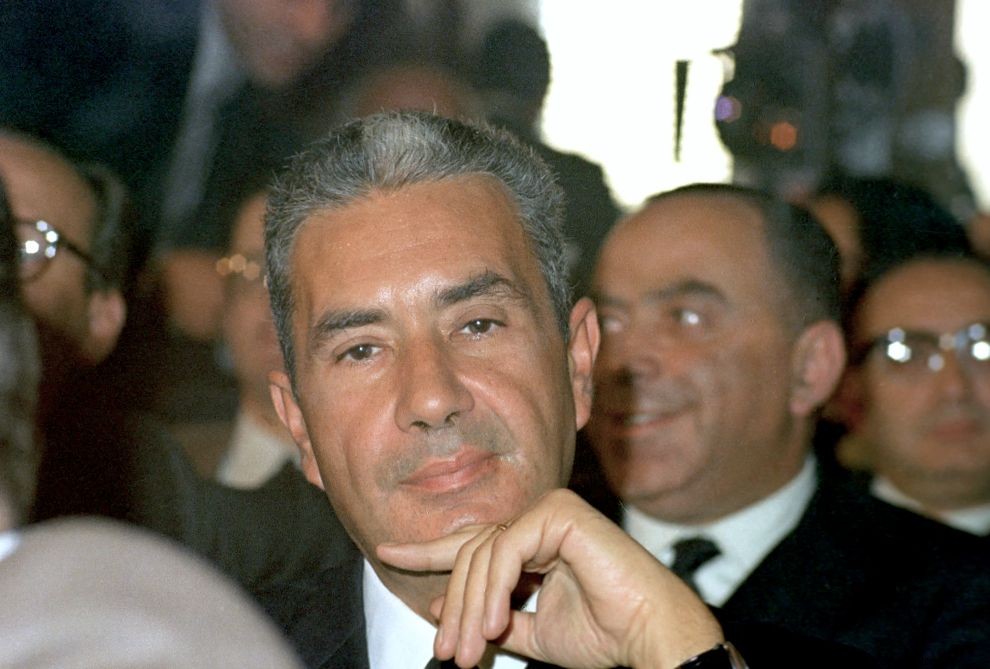
The "historical compromise" of Moreau and Berlinguer troubled many communists, especially the younger ones. Christian Democratic voters may have viewed the rapprochement of the two parties positively, all the more so because the IKK was moving away from the Soviet Union, but the Communists feared that revolution against capitalism was in imminent danger, since their party had decided to cooperate with the number one bourgeois power party.
Much more enraged by the developments were the members of the Red Brigades. The BR intended to strike the entire Christian Democratic party, precisely because they saw it as the main exponent of a regime which, as they described it in their first communique after Moro's kidnapping, was the one "that has oppressed the Italian people for years". According to later statements by members of the organization, the Red Brigades also wanted to kidnap the other leader of the Christian Democrats and prime minister at the time, Giulio Andreotti.
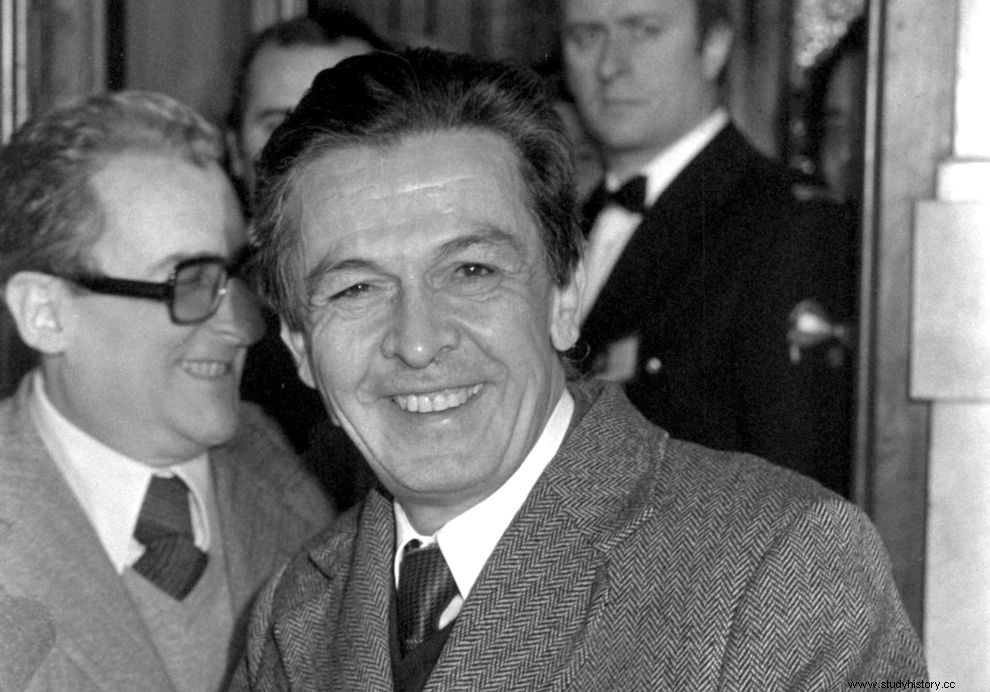
But this plan was abandoned, precisely because Andreotti's police protection was too strong. The other target, the main one, was Aldo Moro, apparently because he was the originator of DC's cooperation with the PCI. Let's not forget that it was the first time since 1947 that the Italian communists had a position - even an indirect one - in the government. The Red Brigades believed that if the kidnapping was successful, it would automatically stop the entry of communists into government positions.
So, convinced of their motives, they began to plan the biggest coup in their eight-year history. According to the official representation in the trials that followed, there were eleven people involved in the attack, but several doubts have been expressed about the statements of the terrorists, on which the official investigations were based. But let's see what happened on the morning of March 16, 1978 in Rome, according to what we know.
THE KIDNAPPING OF MORO (16/3/1978)

The Red Brigades had set up their ambush on Via Mario Fani, a downhill road in northwest Rome, very close to the "Stadio Olimpico". Members of the organization, who had long followed Moro's daily itinerary, took their seats at 8:45 on the morning of March 16. They had parked in four cars. At the top of the road was Mario Moretti, head of BR, in a Fiat 128 with a fake diplomatic number plate. Alvaro Lozzacono and Alessio Casimiri were in another Fiat 128, a few meters ahead of Moretti.
Another Fiat 128 was parked on the opposite side of the road, inside which was Barbara Balzerani, who would be the first to see Moro's car approaching. Finally, a Fiat 132 with Bruno Seghetti was parked further down, where the road ended. Four of the terrorists (Morucci, Gallinari, Fiore and Bonizoli) wore Alitalia uniforms as a precaution because not all members knew each other to avoid friendly fire.
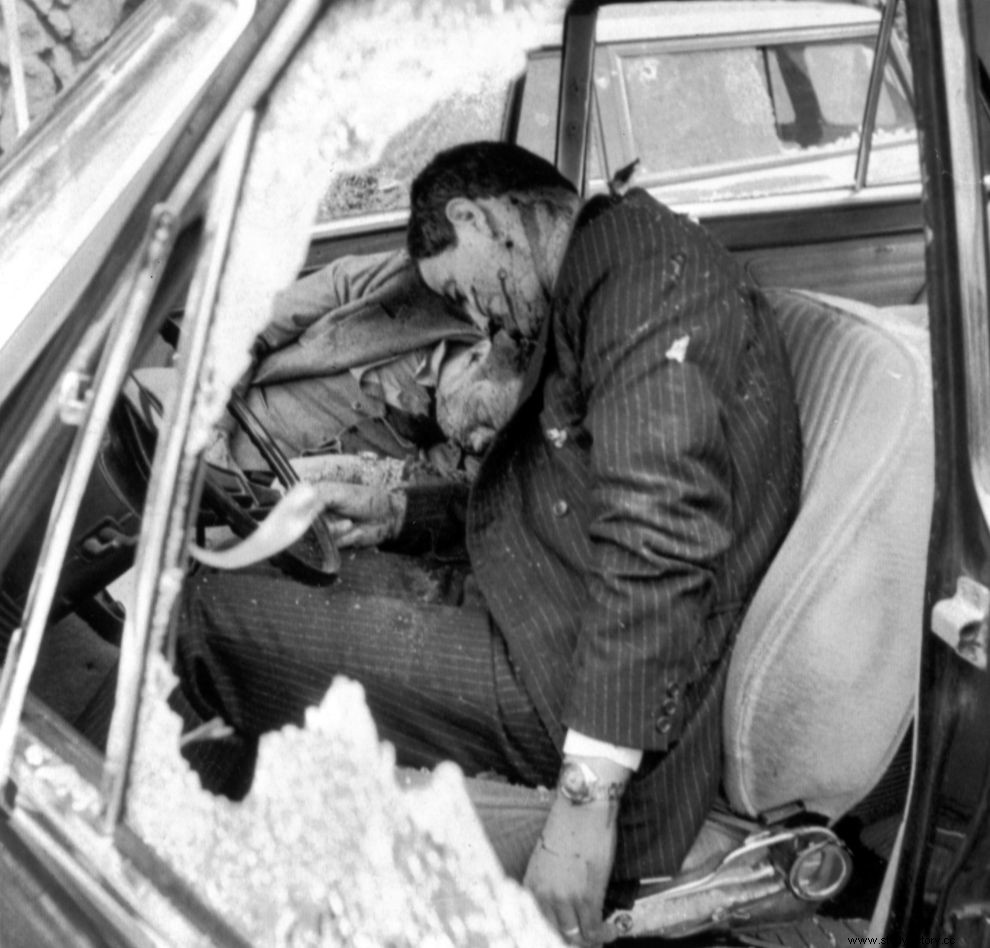
Moro left his home just before 9:00 in a blue Fiat 130, driven by Domenico Ricci, with Oreste Leonardi, head of the bodyguards, sitting next to him. Behind them followed a white Alfetta, in which were the remaining three bodyguards of Moro, Francesco Zizzi, Julio Rivera and Rafaele Iochino. When the two cars entered Via Mario Fani, the terrorists were alerted by Rita Algranati, who was on the corner of the street with Via Trionfale. Algranati signally waved a bouquet of flowers and then left the scene on a moped.
Moretti's Fiat cut into Moro's car from the front. Richie tried to maneuver to escape but was unsuccessful. Immediately after, Lozzacono's Fiat blocked the way for Moro's two cars from the rear. At the same time, the four armed terrorists in Alitalia uniforms who were hidden in bushes by the road, started shooting at the bodyguards. A total of 91 bullets fell, of which 45 hit - and killed - Moro's five companions.

Two FNAB-43 submachine guns and revolvers, including a Beretta M12, were used in the ambush. Moro forced his way into Seggeti's Fiat 132, which was abandoned a few blocks down on Via Licinio Calvo and was found at 9:40 with some blood stains inside. The rest of the cars used in the ambush were found in the following days on the same road. It is characteristic that none of the five bodyguards were armed on the day of the kidnapping, all their weapons were stored in bags in the trunks of the two cars, precisely because they did not expect to be attacked under any circumstances.
Η απίστευτη αποκάλυψη όμως ήρθε από τη σύζυγο του Μόρο, Ελεονόρα Κιαβαρέλι, η οποία κατά τη διάρκεια της δίκης, είπε πως τα όπλα βρίσκονταν στα πορτ-μπαγκάζ, επειδή οι φρουροί δεν ήξεραν να τα χρησιμοποιούν! Η Κιαβαρέλι πρόσθεσε ότι οι σωματοφύλακες δεν είχαν καν εκπαιδευτεί στη σκοποβολή, ενώ για μήνες ο ασύρματος του αυτοκινήτου του Μόρο δε λειτουργούσε! Λίγη ώρα μετά την απαγωγή, οι Ερυθρές Ταξιαρχίες ανέλαβαν την ευθύνη με τηλεφώνημα στο ιταλικό πρακτορείο ειδήσεων ANSA.
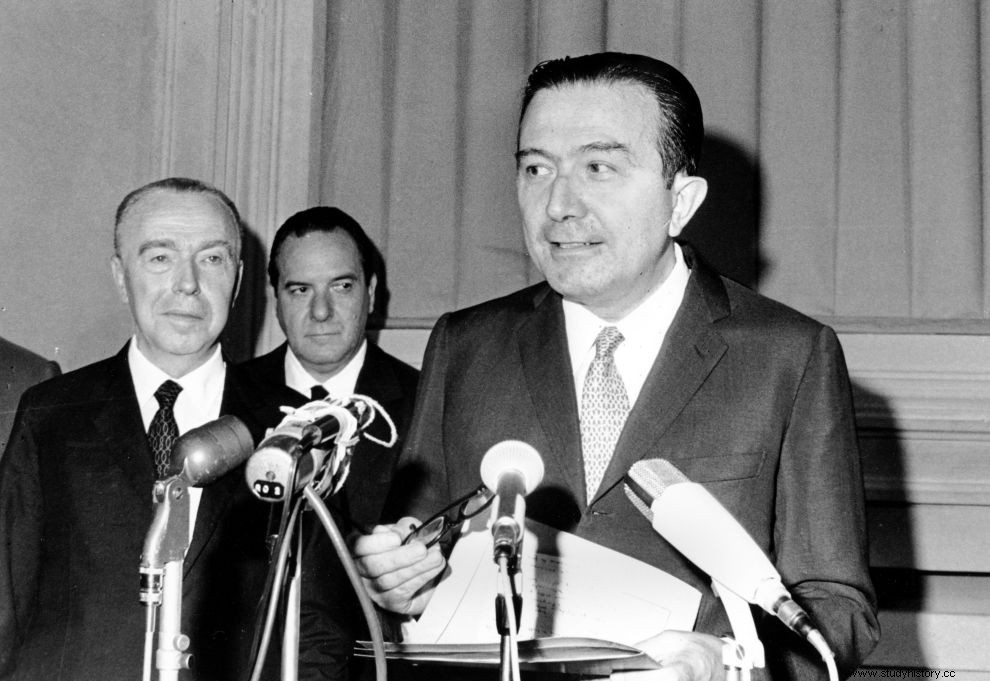
Να πούμε εδώ ότι η ημέρα που έγινε η απαγωγή, δεν ήταν καθόλου τυχαία. Ο Μόρο κατευθυνόταν εκείνο το πρωί στη Βουλή των Αντιπροσώπων, όπου το σώμα θα συνεδρίαζε και στη συνέχεια θα ψήφιζε για να δώσει ψήφο εμπιστοσύνης στον Τζούλιο Αντρεότι, ώστε να σχηματίσει νέα κυβέρνηση με την για πρώτη φορά άμεση συνεργασία του Ιταλικού Κομμουνιστικού κόμματος. Στις 10:00 ακριβώς, ο πρόεδρος της ιταλικής βουλής, Πιέτρο Ινγκράο, διέκοψε τη συνεδρίαση, ανακοινώνοντας την απαγωγή του Άλντο Μόρο από τις Ερυθρές Ταξιαρχίες.
Τελικά, στην ψηφοφορία που διεξήχθη, ο Αντρεότι συγκέντρωσε πολύ μεγάλη πλειοψοφία στις ψήφους, συμπεριλαμβανομένων και εκείνων του PCI, όμως ο Μπερλίνγκουερ, υπό το βάρος των εξελίξεων, περιορίστηκε στη στήριξη των Χριστιανοδημοκρατών, χωρίς να εμπλακεί ενεργά στο κυβερνητικό σχήμα. Ο ηγέτης των Κομμουνιστών μίλησε για ένα χτύπημα που σκοπό είχε να σταματήσει μια θετική πολιτική διαδικασία, ενώ ο Λούτσιο Μάγκρι, εκπρόσωπος του ακροαριστερού PdUP, εξέφρασε την ανησυχία του για νομοσχέδια που με αφορμή την απαγωγή του Μόρο, θα περιόριζαν τις προσωπικές ελευθερίες.
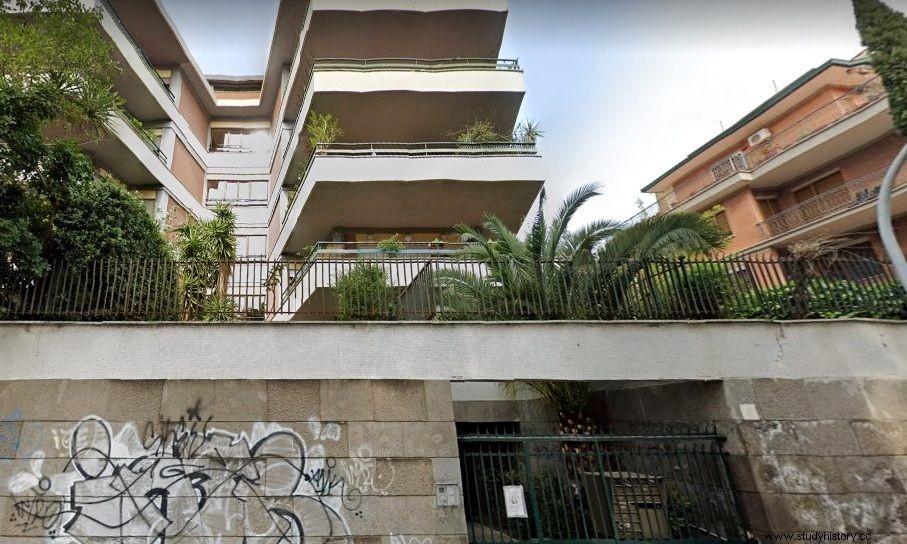
Το πού ακριβώς κρατήθηκε ο Άλντο Μόρο μετά την απαγωγή του, δεν έχει εξακριβωθεί ακόμα. Πάντως, σύμφωνα με τις μαρτυρίες τρομοκρατών στις δίκες που ακολούθησαν, ο Ιταλός πολιτικός οδηγήθηκε σε διαμέρισμα το οποίο ανήκε για κάποια χρόνια σε μέλος των Ερυθρών Ταξιαρχιών και βρισκόταν στον αριθμό 8 της Via Camillo Montalcini, στη νοτιοδυτική περιοχή της Ρώμης. Στο υπόγειο πάρκινγκ της πολυκατοικίας υποτίθεται ότι έλαβε χώρα και η δολοφονία του Μόρο στις 9 Μαΐου του 1978.
Ο αδελφός του Μόρο, Κάρλο Αλφρέντο, δικαστής στο επάγγελμα, αμφισβήτησε αυτή την εκδοχή, υποστηρίζοντας στο βιβλίο του, "Storia di un delitto annunciato", ότι το σημείο κράτησης πρέπει να βρισκόταν σε κάποια παραθαλάσσια τοποθεσία και αυτό επειδή στο αυτοκίνητο που βρέθηκε το πτώμα, υπήρχαν και υπολείμματα άμμου. Οι απαγωγείς ισχυρίστηκαν ότι είχαν ρίξει άμμο και νερό στο θύμα και στο αυτοκίνητο για να παραπλανήσουν τις αρχές, όμως οι ανακριτές και οι ιατροδικαστές δεν πείστηκαν. Το σίγουρο είναι ότι το ακριβές σημείο κράτησης του Μόρο παραμένει μέχρι σήμερα ένα άλυτο μυστήριο.
ΟΙ ΕΠΙΣΤΟΛΕΣ ΤΟΥ ΑΛΝΤΟ ΜΟΡΟ

Κατά τη διάρκεια της κράτησής του από τις Ερυθρές Ταξιαρχίες, ο Άλντο Μόρο έγραψε 86 επιστολές, που απευθύνονταν σε ηγετικά στελέχη του Χριστιανοδημοκρατικού κόμματος, στην οικογένειά του και στον - στενό φίλο του - Πάπα Παύλο τον 6ο. Κάποιες από αυτές έφτασαν στους παραλήπτες τους, ενώ κάποιες άλλες δε στάλθηκαν ποτέ και βρέθηκαν αργότερα σε άλλη γιάφκα της οργάνωσης, στην οδό Monte Nevoso στο Μιλάνο. Σε αυτές τις επιστολές, ο Μόρο προσπαθούσε να βρει σημεία επαφής ανάμεσα στους τρομοκράτες και τους Χριστιανοδημοκράτες ή την κυβέρνηση, ώστε να καρποφορήσουν οι διαπραγματεύσεις και να αφεθεί ελεύθερος.
Τα γράμματα που έγραφε ο Μόρο, παρά το γεγονός ότι δεν τα υπαγόρευαν οι απαγωγείς του, ήταν σε αρκετές περιπτώσεις καθοδηγούμενα από αυτούς. Θεωρείται όμως σίγουρο ότι οι Ερυθρές Ταξιαρχίες δε βασάνισαν ποτέ, ούτε κακομεταχειρίστηκαν τον Μόρο στη διάρκεια της κράτησής του. Δεν ήταν πάντως λίγοι εκείνοι, κυρίως μέλη του Χριστιανοδημοκρατικού κόμματος, που επέκριναν τον Μόρο για την προσπάθειά του να πείσει το κράτος να διαπραγματευτεί με τους τρομοκράτες, με σκοπό να σώσει τη ζωή του.
ΤΑ ΑΝΑΚΟΙΝΩΘΕΝΤΑ ΚΑΙ ΟΙ ΔΙΑΠΡΑΓΜΑΤΕΥΣΕΙΣ
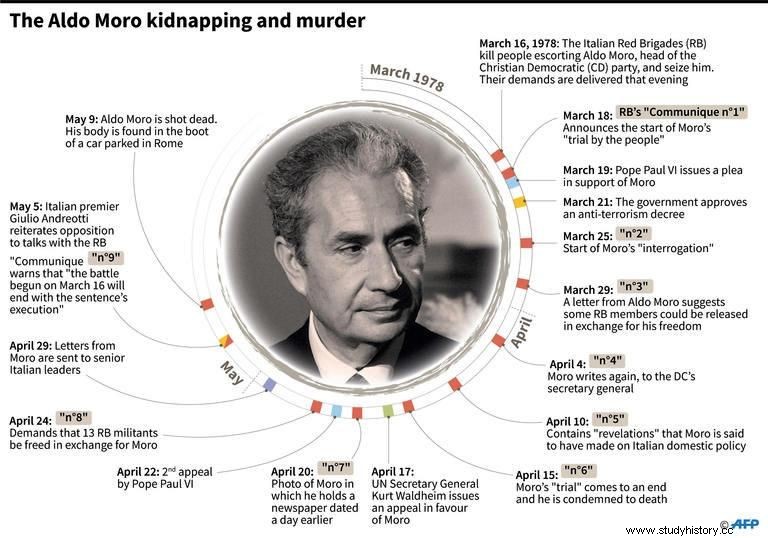
Στη διάρκεια των 55 ημερών της κράτησης του Μόρο, οι Ερυθρές Ταξιαρχίες εξέδωσαν εννέα ανακοινωθέντα ("comunicati"), στα οποία εξηγούσαν αναλυτικά τους λόγους της απαγωγής. Στο τρίτο από αυτά, έγραφαν χαρακτηριστικά:"Η ανάκριση, το περιεχόμενο της οποίας ήδη περιγράψαμε, συνεχίζεται με την πλήρη συνεργασία του κρατούμενου. Οι απαντήσεις του ξεκαθαρίζουν όλο και περισσότερο τις αντεπαναστατικές γραμμές της ιμπεριαλιστικής πρακτικής του νέου καθεστώτος που με κινητήριο άξονα τις Πολυεθνικές, εγκαθιδρύεται στη χώρα μας έχοντας ως βασικό άξονα τη Χριστιανοδημοκρατία".
Στις 22 Απριλίου, ο Πάπας Παύλος ο 6ος, σε δημόσια ομιλία του, ζήτησε από τις Ερυθρές Ταξιαρχίες να αφήσουν τον Μόρο να επιστρέψει στην οικογένειά του, χωρίς να θέτουν όρους και απαιτήσεις. Δυο μέρες αργότερα, στις 24 Απριλίου, με το 8ο ανακοινωθέν τους, οι τρομοκράτες πρότειναν να ανταλλάξουν τον Μόρο με 13 φυλακισμένους συντρόφους τους (αργότερα δέχτηκαν να γίνει ανταλλαγή με μόνο έναν φυλακισμένο τρομοκράτη των BR). Στο μεταξύ, η πολιτική σκηνή της Ιταλίας είχε χωριστεί στα δυο.

Υπήρχαν εκείνοι που ήταν υπέρ των διαπραγματεύσεων, ανάμεσά τους και ο γενικός γραμματέας του Σοσιαλιστικού κόμματος, Μπετίνο Κράξι. Όμως η πλειοψηφία των Χριστιανοδημοκρατών και των Κομμουνιστών, ανάμεσά τους και ο Ενρίκο Μπερλίνγκουερ, θεωρούσαν πως οποιαδήποτε συζήτηση με τις Ερυθρές Ταξιαρχίες, θα σήμαινε αυτόματα νομιμοποίηση της τρομοκρατικής βίας. Επιπλέον, υποστήριζαν, πως η αστυνομία, με τόσα θύματα τα τελευταία χρόνια από τρομοκρατικές επιθέσεις, δε θα αποδεχόταν μια τέτοια λύση.
Ο Μπερλίνγκουερ και ο Ούγκο Λα Μάλφα, ηγέτης των Ρεπουμπλικάνων, είχαν προτείνει τη θανατική ποινή για τους τρομοκράτες. Στις 5 Μαΐου, με το 9ο ανακοινωθέν τους, οι Ερυθρές Ταξιαρχίες ανέφεραν για πρώτη φορά σαφώς το εξής:"Σε ό,τι αφορά την πρότασή μας για ανταλλαγή πολιτικών κρατουμένων με σκοπό την αναστολή της καταδίκης και την απελευθέρωση του Άλντο Μόρο, δεν μπορούμε παρά να καταγράψουμε τη σαφή άρνηση της Χριστανοδημοκρατίας. Ολοκληρώνουμε έτσι τη μάχη που ξεκίνησε στις 16 Μαρτίου, εκτελώντας την ποινή στην οποία καταδικάστηκε ο Άλντο Μόρο". Η αντίδραση του Αντρεότι την ίδια μέρα, ήταν να επαναλάβει την αντίθεσή του σε οποιαδήποτε διαπραγμάτευση με τις BR. Ο χρόνος πλέον μετρούσε αντίστροφα...
Η ΕΚΤΕΛΕΣΗ ΤΟΥ ΑΛΝΤΟ ΜΟΡΟ (9/5/1978)
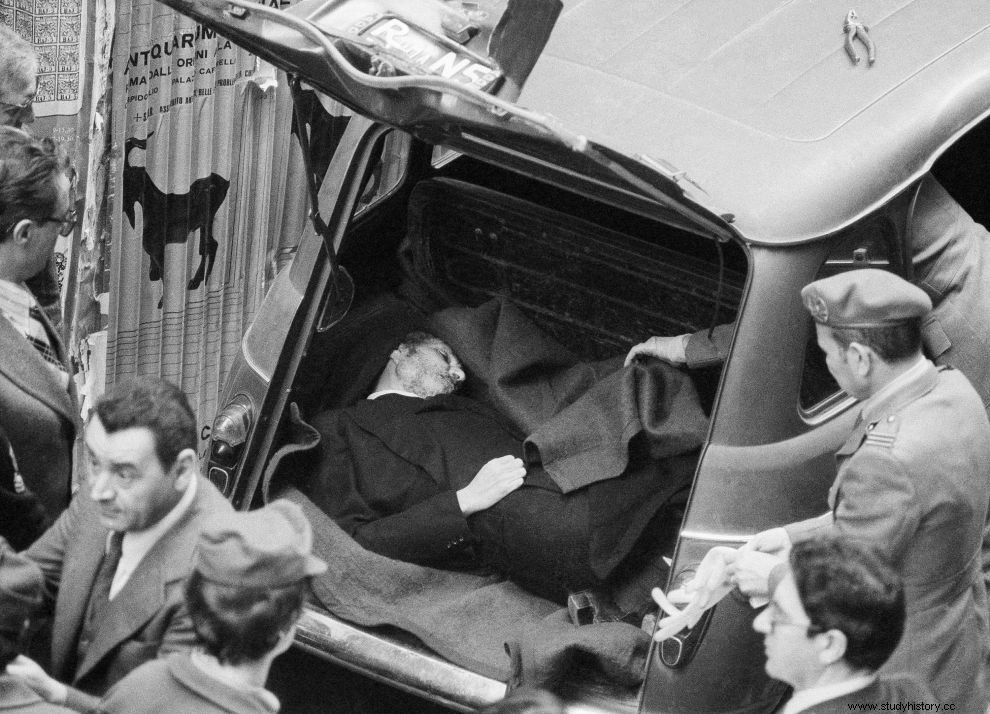
Παρά το γεγονός ότι η "δίκη" του Μόρο από τις Ερυθρές Ταξιαρχίες είχε ολοκληρωθεί στις 15 Απριλίου, κάτι που είχε κάνει γνωστό η οργάνωση με το 6ο της ανακοινωθέν, προσθέτοντας ότι είχε κριθεί ένοχος και είχε καταδικαστεί σε θάνατο, δεν είχαν συμφωνήσει όλα τα μέλη με την εκτέλεσή του. Είναι χαρακτηριστικό ότι ο ο ίδιος ο Μορέτι είχε επικοινωνήσει τηλεφωνικά με τη σύζυγο του Μόρο, ζητώντας της να πιέσει τους Χριστιανοδημοκράτες ηγέτες για διαπραγματεύσεις.
Ένα άλλο μέλος της οργάνωσης, η Αντριάνα Φαράντα, είχε αναφέρει μια νυχτερινή συνάντηση στο Μιλάνο, λίγες μέρες πριν τη δολοφονία, όπου τόσο η ίδια όσο και άλλοι τρομοκράτες, ανάμεσά τους οι Βαλέριο Μορούτσι και Φράνκο Μπονιζόλι, που είχαν πάρει μέρος στην απαγωγή, διαφώνησαν με την απόφαση, η οποία όμως πάρθηκε μετά από ψηφοφορία. Σύμφωνα με τη μαρτυρία ενός μέλους των Ερυθρών Ταξιαρχιών αρκετά χρόνια αργότερα, οι τρομοκράτες ξύπνησαν τον Μόρο στις 6:00 το πρωί, λέγοντάς του ότι θα τον μετέφεραν σε άλλο μυστικό μέρος.
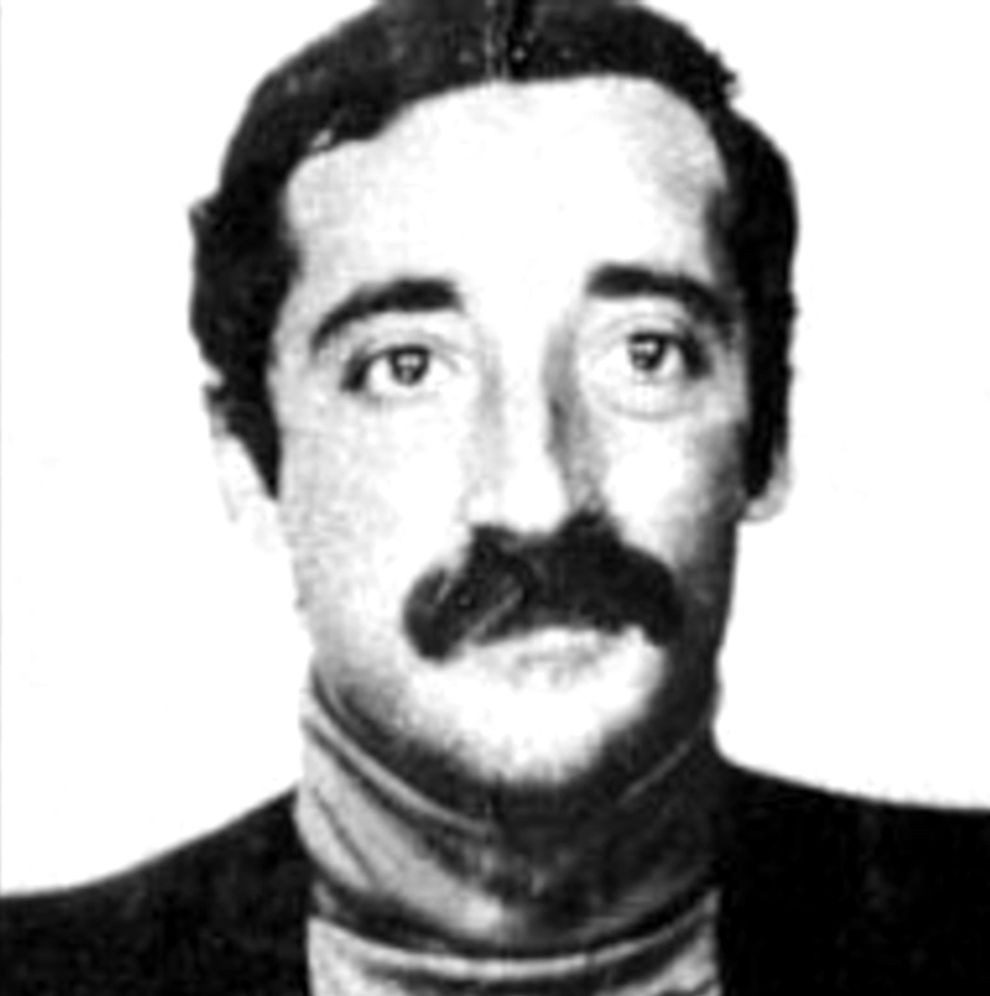
Αντίθετα, σύμφωνα με τη μαρτυρία του Μπονιζόλι, όταν ξύπνησαν τον Μόρο, του είπαν ότι είχε χορηγηθεί αμνηστία και θα τον άφηναν ελεύθερο. Στη συνέχεια τον έβαλαν σε ένα ψάθινο καλάθι και τον μετέφεραν στο γκαράζ της πολυκατοικίας της οδού Camillo Montalcini. Εκεί τον τοποθέτησαν στο πορτ-μπαγκάζ ενός κόκκινου Renault 4 και τον σκέπασαν με ένα κόκκινο σεντόνι. Αμέσως μετά, ο Μάριο Μορέτι πυροβόλησε τον Μόρο με ένα Walther PPK των 9mm, το οποίο όμως μπλόκαρε και συνέχισε με ένα Skorpion vz. 61. Οι σφαίρες τρύπησαν τους πνεύμονες του Μόρο και τον σκότωσαν.
Στη συνέχεια, οι τρομοκράτες οδήγησαν το αυτοκίνητο με το πτώμα στην οδό Michelangelo Caetani, κοντά στον ποταμό Τίβερη και το άφησαν παρκαρισμένο εκεί, μια ώρα περίπου μετά την εκτέλεση. Στις 12:30 τηλεφώνησαν στον Φραντσέσκο Τρίτο, βοηθό του Μόρο, λέγοντάς του την ακριβή τοποθεσία του αυτοκινήτου με το πτώμα. Στις 13:30, ο Βαλέριο Μορούτσι έκανε ένα ακόμα τηλεφώνημα, αυτή τη φορά στο αρχηγείο της Αστυνομίας, ενημερώνοντας ότι το πτώμα του Μόρο βρισκόταν στην οδό Caetani.
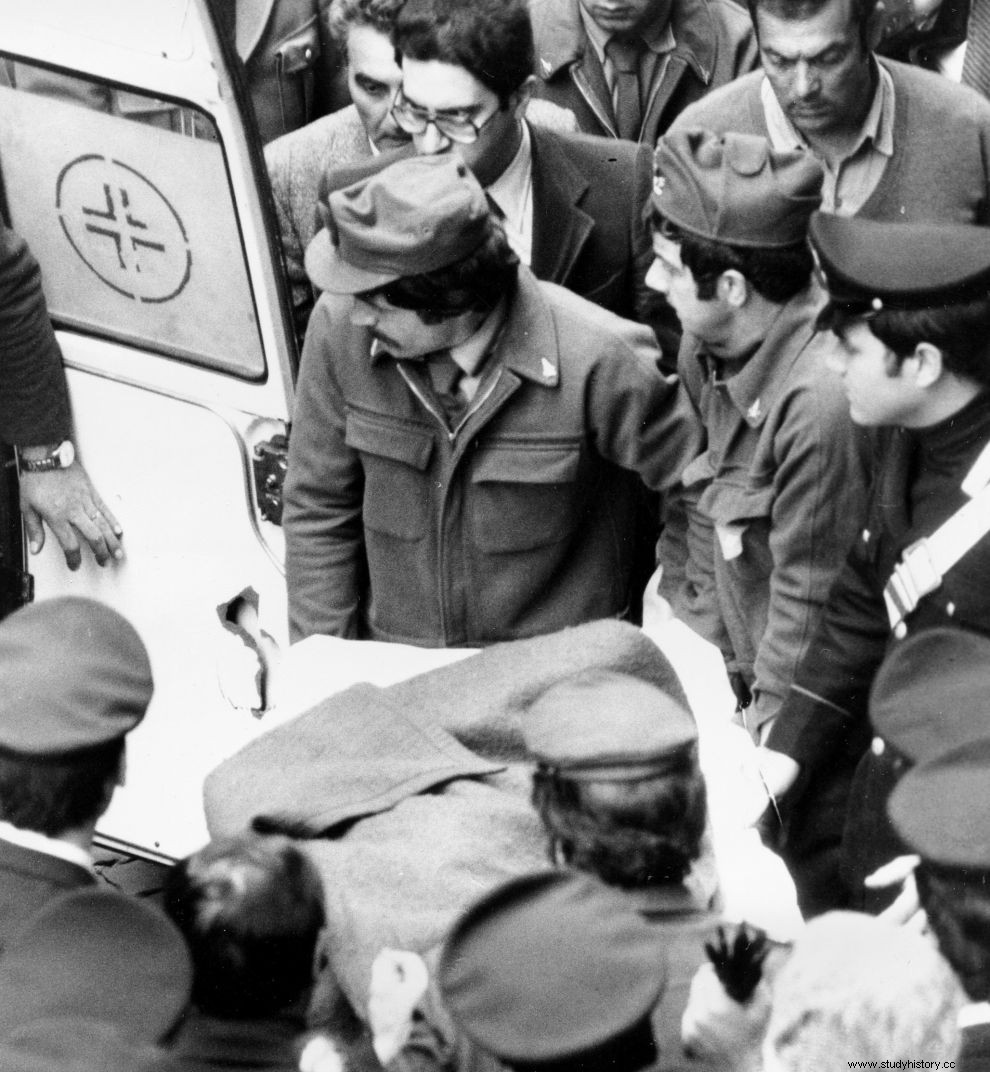
Η ιατροδικαστική έρευνα τοποθέτησε την ώρα του θανάτου ανάμεσα στις 9:00 και τις 10:00 το πρωί. Ο Μόρο φορούσε τα ίδια γκρίζα ρούχα που είχε και την ημέρα της απαγωγής του. Ήταν γεμάτος με κηλίδες αίματος, ενώ ίχνη άμμου βρέθηκαν στις τσέπες και τις κάλτσες του, καθώς και υπολείμματα λαχανικών. Στο πορτ-μπαγκάζ υπήρχαν κάποια προσωπικά αντικείμενα του νεκρού, ένα βραχιόλι, το ρολόι του και μερικά άδεια φυσίγγια. Ο Μόρο είχε και ένα τραύμα στον μηρό, το οποίο είχε υποστεί πιθανότατα την ημέρα της απαγωγής του.
Το σοκ ήταν τεράστιο για όλη την Ιταλία, που βυθίστηκε στο πένθος. Παρά το γεγονός ότι είχαν περάσει σχεδόν δυο μήνες από την απαγωγή του Μόρο και δεν είχε υπάρξει η παραμικρή πρόοδος στις διαπραγματεύσεις, οι Ιταλοί πίστευαν πως έστω και την ύστατη ώρα θα βρισκόταν κάποια λύση, χωρίς να χρειαστεί να χυθεί αίμα. Αμέσως μετά την είδηση της δολοφονίας, παραιτήθηκε ο υπουργός των Εσωτερικών, Φραντσέσκο Κοσίγκα (ήταν αντίθετος σε οποιαδήποτε διαπραγμάτευση με τις BR), για τον οποίο ο Μόρο, σε μια από τις επιστολές του, είχε γράψει "το αίμα μου θα πέσει πάνω του".
ΜΕΤΑ ΤΗ ΔΟΛΟΦΟΝΙΑ ΤΟΥ ΑΛΝΤΟ ΜΟΡΟ

Αμέσως μετά τη δολοφονία του Μόρο, σχηματίστηκαν τρεις "επιτροπές κρίσης", μια επιχειρησιακή-πολιτική επιτροπή, μια επιτροπή πληροφοριών και τέλος, μια επιτροπή εμπειρογνωμόνων, της οποίας ποτέ δεν έγιναν γνωστές οι αποφάσεις και δραστηριότητες. Καμία όμως από αυτές τις επιτροπές δεν κατέληξε σε σαφή πορίσματα σχετικά με την υπόθεση Μόρο και αυτό επειδή η μεθοδολογία τους ήταν τελείως ξεπερασμένη, αφού βασιζόταν σε πρότυπα της δεκαετίας του '50 και δεν προέβλεπε την κατανόηση και την καταπολέμηση της εσωτερικής τρομοκρατίας, που είχε εμφανιστεί στην Ιταλία πολύ αργότερα, στα τέλη της δεκαετίας του '60.
Μέχρι σήμερα έχει εξακριβωθεί ότι δέκα ήταν οι τρομοκράτες που πήραν μέρος στην απαγωγή του Μόρο, παρά το γεγονός ότι οι μαρτυρίες των ίδιων των μελών της οργάνωσης μιλούσαν για περισσότερους (έντεκα στην απαγωγή και αρκετούς περισσότερους στην κράτηση και στη δολοφονία). Από τους δέκα, συνελήφθησαν οι οκτώ και καταδικάστηκαν σε διάφορες ποινές, με μεγαλύτερη εκείνη του Μάριο Μορέτι (έξι φορές σε ισόβια). Όμως, το ιταλικό κράτος, κυρίως μετά τη σύλληψη το 1979 πολλών ηγετικών στελεχών των Ερυθρών Ταξιαρχιών και εκατοντάδων μελών τους, πρότεινε μια "πολιτική λύση" στους φυλακισμένους της οργάνωσης.

Οι περισσότεροι κρατούμενοι αποδέχτηκαν αυτή την πρόταση (εξαίρεση αποτέλεσαν ο Ρενάτο Κούρτσιο και η ομάδα του Τζιοβάνι Σεντσάνι, ενός καθηγητή εγκληματολογίας που είχε δραστηριοποιηθεί στις Ερυθρές Ταξιαρχίες) και αφέθηκαν ελεύθεροι με αντάλλαγμα τη δημόσια αποκήρυξη της ένοπλης πάλης. Σε ό,τι αφορά τους οκτώ της υπόθεσης Μόρο, όλοι βγήκαν από τη φυλακή, είτε με περιοριστικούς όρους, είτε χωρίς, εκτός από τη Ρίτα Αλγκρανάτι, που συνελήφθη το 2004 στο Κάιρο και εκτίει ακόμα την ποινή της.
Ο ένατος, Αλβάρο Λοτζάκονο, διέφυγε στην Ελβετία, συνελήφθη το 2004 στην Κορσική, αλλά δεν εκδόθηκε ποτέ στην Ιταλία. Ο δέκατος, Αλέσιο Καζιμίρι, διέφυγε στη Νικαράγουα, όπου είναι ιδιοκτήτης ενός εστιατορίου. Η δίκη των κατηγορούμενων για τη δολοφονία του Μόρο - η πρώτη, γιατί ακολούθησαν και άλλες - διεξήχθη το 1982 στη Ρώμη, προκαλώντας το παγκόσμιο ενδιαφέρον. Εκεί μπήκε η σφραγίδα του τέλους μιας οργάνωσης που είχε αποδεκατιστεί από τις συλλήψεις, τις διαφοροποιήσεις και τις ομολογίες των μεταμελημένων.

Οι τρομοκρατικές επιθέσεις στα επόμενα χρόνια, την ευθύνη των οποίων ανέλαβαν οι Ερυθρές Ταξιαρχίες, ήταν απλά οι τελευταίες γραμμές στο χρονικό ενός προαναγγελθέντος θανάτου, αφού η οργάνωση είχε χάσει κάθε έρεισμα στο λαό, μαζί και τη μαζική υποστήριξη από χιλιάδες συμπαθούντες, που γύρισαν την πλάτη τους στις BR μετά τη δολοφονία του Μόρο. Ο Ενρίκο Φέντσι, ένας από τους ιδεολογικούς εκπροσώπους της, είχε πει χαρακτηριστικά:"Το κεφάλαιο Ερυθρές Ταξιαρχίες έχει ουσιαστικά κλείσει".
Και είχε αναλύσει αυτό συμπέρασμά του μέσα σε ελάχιστες προτάσεις:"Η ένοπλη πάλη έχασε όλα τα πολιτικά και κοινωνικά ραντεβού της τελευταίας δεκαετίας. Αν δεν έχουμε το θάρρος να απορρίψουμε συνολικά την ένοπλη βία, είμαστε καταδικασμένοι να μην καταλάβουμε αυτά που συμβαίνουν, είμαστε καταδικασμένοι στην τρέλα. Και τούτο επειδή, σε αυτό το στάδιο, η αποτυχία των Ερυθρών Ταξιαρχιών ισοδυναμεί με την αποτυχία της ένοπλης πάλης στη χώρα μας"...
